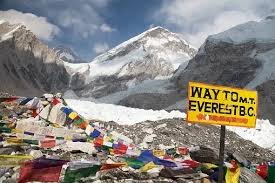Scaling Dreams Everest Base Camp Trek
Scaling the Everest Base Camp trek is a journey that transforms a dream into reality for many adventure seekers. Nestled at the foot of the world’s highest peak, this trek epitomizes the allure of the Himalayas, offering a blend of breathtaking landscapes, profound personal challenge, and cultural richness. For those who embark on this journey, reaching Everest Base Camp symbolizes not only a physical achievement but also a deeply rewarding experience that resonates on multiple levels.
The trek begins with a dramatic flight from Kathmandu to Lukla, a gateway to the Everest region, where the adventure truly starts. From Lukla, the trail meanders through the lush Khumbu Valley, crossing suspension bridges and passing through vibrant Sherpa villages. The route unfolds with stops in places like Namche Bazaar, a bustling hub at 3,440 meters (11,286 feet) that offers stunning views of surrounding peaks and serves as an acclimatization point. This vibrant town, with its colorful markets and traditional lodges, is a place where trekkers acclimate both physically and culturally.
As the trek progresses, the landscape transforms dramatically. The verdant terrain gradually gives way to alpine meadows, rocky moraines, and icy glaciers. Tengboche, known for its monastery and panoramic mountain views, provides a serene stop with its spiritual atmosphere. The journey to Dingboche and Lobuche involves ascending through increasingly challenging terrain, with each step offering more striking vistas of Everest and its neighboring giants, Lhotse and Nuptse.
The final push to Everest Base Camp is both a physical and emotional milestone. Reaching Base Camp, situated at 5,364 meters (17,598 feet), is a moment of triumph. The camp itself is a bustling enclave of climbers, trekkers, and support staff, surrounded by the stark beauty of the Khumbu Glacier and the towering walls of Everest. Standing at this base, with the colossal mountain towering above, instills a sense of awe and accomplishment that few experiences can match.
Throughout the trek, trekkers encounter challenges such as altitude sickness and unpredictable weather. However, the rewards far outweigh the difficulties. The opportunity to witness the grandeur of Everest, to interact with the resilient Sherpa people, and to immerse oneself in the raw beauty of the Himalayas makes this journey unforgettable. Scaling dreams through the Everest Base Camp trek is not just about reaching a physical destination but about embracing a profound adventure that leaves a lasting impact on the soul.
Introduction to Scaling Dreams
Scaling dreams through the Everest Base Camp trek is an adventure of a lifetime, drawing trekkers from around the globe who seek to witness the majestic beauty of the world’s highest peak. This trek is more than a physical journey; it represents a quest for personal achievement and a chance to experience the profound splendor of the Himalayas. The trek offers a unique blend of rugged terrain, stunning vistas, and cultural immersion, making it a quintessential adventure for those passionate about trekking and mountaineering. Starting from the bustling city of Kathmandu and extending to the serene base of Mount Everest, the trek is a culmination of careful planning, physical endurance, and a deep appreciation for the natural world. It is a journey where each step brings trekkers closer to their dreams while providing an opportunity to connect with the land and its people in a way that few other adventures can offer. e-bike for hilly terrain
Overview of Everest Base Camp
Everest Base Camp, perched at an altitude of 5,364 meters (17,598 feet), serves as the primary staging point for climbers attempting to summit Mount Everest. For trekkers, it represents the pinnacle of their adventure, offering an up-close view of the world’s highest peak. The trek to Base Camp traverses through the Khumbu Valley, passing through picturesque Sherpa villages, lush forests, and dramatic glacial landscapes. Key highlights include the vibrant market town of Namche Bazaar, the spiritual Tengboche Monastery, and the rugged, high-altitude terrain leading to the base camp. The final approach to Base Camp takes trekkers through the Khumbu Glacier, where the immense scale of Everest becomes truly awe-inspiring. The camp itself is a bustling hub of activity, with climbers preparing for their ascent and trekkers reveling in the sheer magnitude of their achievement. This destination offers not only a breathtaking view of Everest but also a profound sense of accomplishment and connection to the world’s highest mountain.
Preparing for the Trek
Preparing for the Everest Base Camp trek involves meticulous planning and physical readiness to ensure a successful and enjoyable journey. Start by selecting the ideal trekking season, typically in spring or autumn, when weather conditions are most favorable. Obtain the necessary permits, including the Sagarmatha National Park Permit and TIMS (Trekkers’ Information Management System) card, well in advance. Physical preparation is crucial; engage in cardiovascular exercises, strength training, and endurance hikes to build stamina and resilience. Familiarize yourself with the trek’s demands and train on similar terrains if possible. Mental preparation is equally important; understanding the challenges of high-altitude trekking and being mentally prepared for long days and unpredictable weather can significantly impact your experience. Finally, choose a reliable trekking agency or guide to handle logistics, provide local insights, and ensure safety throughout the trek. By investing time and effort into thorough preparation, you set the stage for a memorable and successful trek to Everest Base Camp.
Route Options and Itineraries
The Everest Base Camp trek offers several route options and itineraries to suit different preferences and time constraints. The most popular route begins with a flight from Kathmandu to Lukla, followed by a trek through the Khumbu Valley. From Lukla, the standard itinerary includes stops at Phakding, Namche Bazaar, Tengboche, Dingboche, Lobuche, and Gorak Shep before reaching Base Camp. This route allows for gradual acclimatization and provides opportunities to explore notable landmarks and villages along the way. For those seeking a more immersive experience, alternative itineraries might include additional stops, such as Gokyo Lakes or a detour to Island Peak, adding variety and extra acclimatization. Some trekkers opt for shorter itineraries, focusing on a direct route with fewer rest days, while others may choose longer treks to fully appreciate the region’s beauty and cultural heritage. Each itinerary offers a unique perspective on the Everest region, catering to different interests and trekking abilities.
Essential Gear and Supplies
Equipping yourself with the right gear and supplies is crucial for a successful trek to Everest Base Camp. Begin with sturdy, well-fitted trekking boots that provide ankle support and traction on uneven terrain. Layering is essential due to varying weather conditions; pack moisture-wicking base layers, insulating mid-layers, and a waterproof, windproof outer shell. A high-quality sleeping bag rated for cold temperatures is necessary for comfort during nights at high altitudes. Essential accessories include a wide-brimmed hat, gloves, sunglasses with UV protection, and trekking poles for stability. A durable backpack with ample capacity and a comfortable fit will carry your gear, while a headlamp with extra batteries ensures visibility in low-light conditions. Include a first-aid kit with medications for common ailments, a water purification system or tablets, and personal hygiene items. Hydration systems, such as water bottles or hydration packs, are crucial for staying hydrated throughout the trek. By preparing with the right gear and supplies, you ensure comfort and readiness for the challenges of the Everest Base Camp trek.
Acclimatization and Health Tips
Acclimatization is a critical component of a successful Everest Base Camp trek, given the significant altitude gains and reduced oxygen levels encountered along the journey. To minimize the risk of altitude sickness, it’s essential to follow a gradual ascent plan. This means allowing your body time to adjust to higher altitudes by incorporating rest days and ascending slowly. For example, spending extra time at key points such as Namche Bazaar and Dingboche helps your body adapt to the thinner air. The “climb high, sleep low” approach, where you trek to higher elevations during the day but return to a lower altitude to sleep, can also aid acclimatization. Staying well-hydrated by drinking plenty of water is crucial, as dehydration can exacerbate symptoms of altitude sickness. Avoid alcohol and heavy meals, which can interfere with your body’s ability to acclimate. Be attentive to your body’s signals; symptoms like headaches, dizziness, and nausea should be addressed promptly. In severe cases, descending to a lower altitude may be necessary. Carrying a basic first-aid kit and knowing the symptoms of altitude sickness can help manage health issues effectively. By prioritizing acclimatization and health, you enhance your chances of a successful and enjoyable trek to Everest Base Camp.
Daily Trekking Experience
Each day on the Everest Base Camp trek offers a unique blend of adventure, challenge, and discovery. Trekkers typically start their days early to make the most of daylight hours. The daily trek involves walking through varied terrains, from lush forests and quaint villages to rocky trails and alpine meadows. Mornings usually include a hearty breakfast at the lodge before setting out on the trail. Trekkers follow a well-marked path, encountering picturesque landscapes and crossing suspension bridges over rushing rivers. Lunch is often enjoyed at a local teahouse or a scenic spot along the route, providing an opportunity to rest and refuel. The afternoons involve continued trekking to the day’s destination, which could be a village like Namche Bazaar or a higher stop like Dingboche. Upon reaching the day’s endpoint, trekkers can relax, explore the area, and prepare for the next day’s journey. Evenings are spent in lodges where trekkers enjoy local meals, socialize with fellow trekkers, and reflect on the day’s experiences. Each day’s trekking experience combines physical effort with the reward of stunning Himalayan views and cultural encounters, making the journey to Everest Base Camp both challenging and immensely gratifying.
Cultural Encounters along the Trail
Cultural encounters are a rich and rewarding aspect of the 12 Days Everest Base Camp trek, offering trekkers a glimpse into the lives of the Sherpa people and their vibrant traditions. As you trek through the Khumbu Valley, you pass through several Sherpa villages, each with its unique charm and cultural significance. Namche Bazaar, a bustling market town, is a cultural hub where you can witness local trade, traditional architecture, and vibrant festivals. Tengboche, known for its monastery, provides an opportunity to observe Buddhist rituals and gain insight into the spiritual practices of the Sherpa community. Interactions with local families and guides offer firsthand experiences of Sherpa hospitality and their traditional way of life. Participating in daily routines, such as sharing a meal or visiting a local school, allows trekkers to understand the close-knit nature of Sherpa society. Respecting local customs, such as removing shoes before entering homes and monasteries, and asking for permission before taking photographs, fosters positive interactions. These cultural encounters enhance the trekking experience, providing a deeper appreciation of the region’s heritage and the warmth of its people.
Safety Precautions and Emergency Plans
Ensuring safety on the Everest Base Camp trek requires careful planning and adherence to precautions. Altitude sickness is a primary concern, so following acclimatization strategies and monitoring symptoms closely is essential. Carry a basic first-aid kit with medications for common ailments and altitude sickness, and ensure you have comprehensive travel insurance that includes emergency evacuation. Always trek with a guide or in a group to enhance safety and support. Familiarize yourself with the symptoms of altitude sickness and have a plan for descending to a lower altitude if necessary. Weather conditions in the Himalayas can be unpredictable; dress in layers and carry waterproof gear to adapt to changing weather. Keep an eye on trail conditions and be cautious of potential hazards like slippery paths or rockfalls. Establish an emergency plan, including communication options with your trekking agency or guide, and know the locations of nearby medical facilities. By taking these safety precautions and having a clear emergency plan, you can navigate the challenges of the trek and ensure a safe and enjoyable journey to Everest Base Camp.
Photography and Scenic Highlights
The Everest Base Camp trek is a photographer’s paradise, offering countless opportunities to capture the breathtaking beauty of the Himalayas. The journey features diverse landscapes, from lush green valleys and traditional Sherpa villages to rugged high-altitude terrain and icy glaciers. Key scenic highlights include the panoramic views from Namche Bazaar, where the towering peaks of Everest, Lhotse, and Ama Dablam dominate the skyline. The approach to Tengboche provides a serene setting with its monastery framed by majestic mountains. As you trek towards Base Camp, the Khumbu Glacier offers dramatic ice formations and sweeping glacier views. The final ascent to Everest Base Camp reveals a bustling camp surrounded by the stark, dramatic beauty of the Khumbu Icefall and towering peaks. Sunrise and sunset are particularly magical times for photography, as the golden light casts dramatic shadows and highlights the textures of the landscape. To capture these moments effectively, use a tripod for stability, and consider bringing a polarizing filter to manage reflections and enhance colors. By embracing the opportunities for stunning photography, you can preserve the memories of your Everest Base Camp trek and share the awe-inspiring beauty of the Himalayas.
Challenges of the Trek
The trek to Everest Base Camp is a formidable challenge that tests both physical endurance and mental resilience. One of the primary hurdles is dealing with the high altitude. As you ascend, the reduced oxygen levels can lead to altitude sickness, causing symptoms such as headaches, nausea, and dizziness. Proper acclimatization is crucial; trekkers need to allow their bodies time to adjust to the thinning air. The physical demands of the trek are significant as well. The route involves long days of walking on varied terrain, including steep ascents, rocky paths, and icy stretches. Trekkers often face fatigue and muscle strain, requiring stamina and determination to push through. Weather conditions can also be unpredictable, with sudden snowfalls, rain, or temperature drops posing additional challenges. Navigating these conditions requires flexibility and preparedness. Furthermore, the trek can be mentally taxing, as trekkers cope with the isolation and the relentless pace of the journey. Despite these challenges, the rewards of reaching Everest Base Camp and witnessing the majestic Himalayan landscape make the effort worthwhile. By preparing thoroughly and staying resilient, trekkers can overcome these obstacles and achieve their goal.
Reflections from Trekkers
Reflections from those who have completed the Everest Base Camp trek often highlight a mix of awe, personal growth, and accomplishment. Many trekkers describe the experience as transformative, citing the physical and mental challenges as opportunities for self-discovery and personal achievement. The trek’s rigorous demands often lead to a deep sense of pride and satisfaction upon reaching Base Camp. Trekkers frequently speak of the stunning vistas, the overwhelming beauty of the Himalayas, and the camaraderie shared with fellow trekkers and guides. Interactions with local Sherpa people and immersion in their culture add a meaningful layer to the journey, enriching the overall experience. The moments of struggle, such as battling altitude sickness or enduring harsh weather, are often reflected upon with a sense of triumph and resilience. Trekkers also remember the profound peace and sense of achievement that comes with standing at the foot of Everest, surrounded by the world’s highest peaks. These reflections underscore the trek’s impact on personal growth and the lasting memories created through the adventure.
Environmental Awareness
Environmental awareness is crucial on the Everest Base Camp trek, given the sensitive nature of the Himalayan ecosystem. The influx of trekkers and climbers has put significant pressure on the region’s environment, making responsible practices essential. Trekkers should adhere to the principle of “leave no trace” by carrying out all waste, including packaging and used toilet paper. Proper waste disposal is critical; use designated facilities to avoid contaminating natural water sources. Minimizing impact on local flora and fauna is also important. Stick to established trails to prevent soil erosion and damage to vegetation. Avoid disturbing wildlife and maintain a respectful distance. Supporting local conservation efforts, such as participating in clean-up campaigns or donating to environmental organizations, can also contribute to preserving the region’s beauty. By practicing environmental awareness, trekkers help ensure that the Everest Base Camp region remains pristine for future adventurers and continues to inspire awe and wonder.
Community and Support
The sense of community and support on the Everest Base Camp trek is a vital aspect of the journey, significantly enhancing the experience. Trekkers often find camaraderie among fellow adventurers, sharing the highs and lows of the trek and providing mutual encouragement. Group trekking with experienced guides fosters a supportive environment, as guides offer valuable assistance, local knowledge, and motivation throughout the journey. The Sherpa community plays a crucial role, providing hospitality, logistical support, and insights into their culture and traditions. Their expertise in navigating the rugged terrain and managing the challenges of high-altitude trekking is invaluable. Trekkers also benefit from the shared experiences and stories of others who have undertaken the trek, creating a network of support and inspiration. Building connections with fellow trekkers and local guides contributes to a sense of belonging and enhances the overall adventure. This supportive network not only aids in overcoming challenges but also enriches the trek with meaningful interactions and lasting friendships.
Conclusion and Future Adventures
The trek to Everest Base Camp is a remarkable journey that culminates in a profound sense of achievement and fulfillment. Reaching Base Camp, surrounded by the majestic peaks of the Himalayas, is a testament to the trekker’s perseverance, preparation, and spirit of adventure. The experience leaves a lasting impression, often inspiring trekkers to pursue future adventures and explore new challenges. The lessons learned and the personal growth achieved during the trek can ignite a passion for further exploration, whether in other mountainous regions or through different forms of adventure travel. The memories of the stunning landscapes, the camaraderie with fellow trekkers, and the rich cultural encounters create a foundation for future journeys. As trekkers reflect on their Everest Base Camp adventure, they often find themselves motivated to continue exploring the world and embracing new experiences. The trek serves as a powerful reminder of the rewards that come from pushing one’s limits and venturing into the unknown, setting the stage for a lifetime of adventure and discovery.







